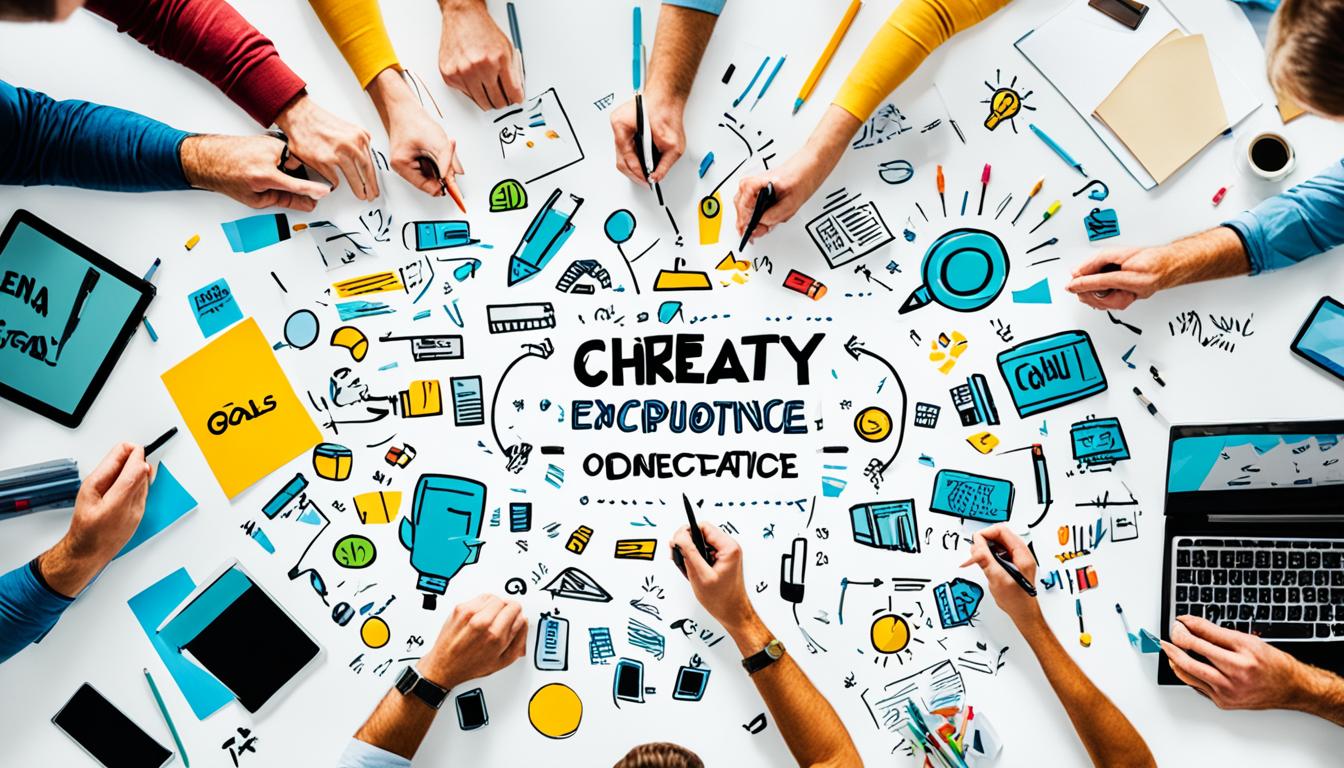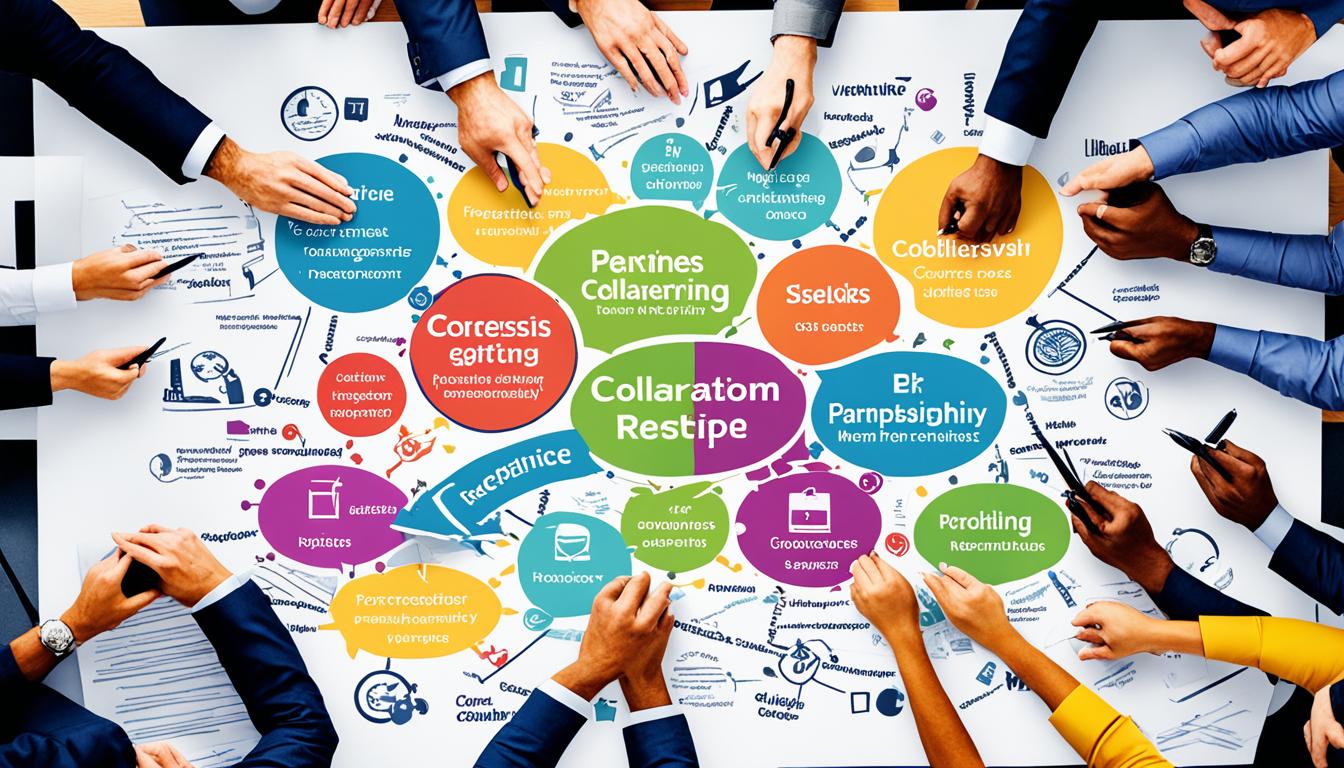A successful partnership meeting is a key strategic tool that enhances collaboration, drives decision-making, and reinforces shared objectives. In today’s fast-paced professional environment, Zippia research indicates that an average worker spends 31 hours a week in unproductive meetings. Therefore, understanding the meeting essentials and integrating them into your routine can transform these sessions into productive meetings, amplifying partnership productivity.

Implementing meeting ground rules can significantly help maximize productivity and ensure successful outcomes. By setting clear meeting agendas, punctuality, and maintaining a focused presence, teams can prevent meetings from running overtime and ensure they are both mentally and physically present for active participation. This level of preparedness, including reading the agenda and providing necessary updates, enhances the effectiveness of the meeting.
Clear collaboration in deciding the next steps boosts engagement and ownership of meeting outcomes. Sticking to deadlines within the meeting promotes focus and encourages positivity, which in turn, enhances team dynamics. This atmosphere fosters a supportive environment where proactive approaches to finding solutions flourish, ultimately improving problem-solving skills.
Productive meetings do not end with the final agenda item; recording meeting notes and action items is crucial for tracking progress and creating a knowledge base. Evaluations of meeting ground rules post-session can lead to essential adjustments, ensuring continuous improvement. With 56% of meetings being held with or for partners, the strategic implementation of these elements ensures each session is both productive and aligned with overall partnership goals.
By understanding and incorporating these essential elements, your partnership meetings can transition from routine gatherings to powerful tools that drive significant achievements. Embrace these strategies to foster successful partnerships and meaningful productivity.
Establish Clear Goals and Objectives
Initiating partnership meetings with clear goals and objectives is essential for a productive session. Setting a clear direction helps focus the discussion and ensures that every participant understands the meeting goals. According to an Economist study, 90% of senior executives from corporations with billion-dollar revenues admitted they failed to meet their strategic goals due to poor implementation.

Define Outcomes
To achieve successful meetings, it is critical to define meeting outcomes clearly. This provides a roadmap for participants and sets the expectations for what the meeting intends to achieve. HBS Professor Robert Simons emphasizes using a balanced scorecard to track non-financial measures and ensure the achievability of business goals and objectives. Clear outcomes help in aligning team efforts and ensuring every discussion leads to actionable results.
Set Measurable Targets
Setting measurable objectives during meetings is crucial to tracking progress and accomplishments. These targets offer a benchmark against which the success of the meeting can be gauged. Examples include increasing revenue, cutting costs, or improving cash flow. Tom Siebel, founder of C3.ai, emphasizes measuring and tracking customer satisfaction effectively.
Ensure Alignment
Ensuring strategic alignment of meeting goals with the broader organizational objectives is fundamental. This alignment solidifies the relevance and direction of the meeting, ensuring it contributes to the company’s overall strategy. Tom Polen, CEO of Becton Dickinson, underscores the importance of balanced goal setting across various perspectives, including financial performance, quality assurance, innovation, and human talent.
By following these steps, partnership meetings can move beyond mere discussions and drive towards tangible, measurable outcomes that align with strategic goals.
Effective Communication Strategies
Effective communication is the backbone of any successful partnership meeting. Embracing strategies like the IEEI framework and fostering active listening and open discussions can significantly enhance the productivity and cohesiveness of the meeting. These approaches ensure that everyone’s voice is heard and their perspectives are considered, ultimately leading to stronger, more collaborative partnerships.
Use of IEEI Framework
The IEEI framework—inform, excite, empower, involve—is a potent tool for guiding the structure of partnership meetings. Informing participants at the outset ensures everyone is on the same page. Exciting the team about the meeting’s objectives can increase engagement levels. Empowering individuals fosters a sense of ownership, while involving everyone in the discussion allows for a more inclusive and effective communication environment.
Encourage Active Listening
Active listening is crucial in partnership meetings, as it ensures that all participants feel valued and understood. This practice involves paying close attention to the speaker, asking clarifying questions, and providing feedback. By encouraging active listening, partnerships can improve their internal communication, which is essential for achieving objectives and fostering a positive, collaborative atmosphere.
Facilitate Open Discussions
Open discussions enable participants to share their thoughts and ideas freely, which is vital for identifying opportunities and addressing challenges. Creating an environment where open discussions are encouraged helps in building trust and transparency within the partnership. This practice not only boosts internal support but also enhances external communications, ultimately leading to higher levels of public engagement and trust.
According to the Partnership Protocol, clear and effective communication both internally and externally is key to the success of public-private partnerships. By adopting these strategies, partnerships can ensure they are transparent and inclusive, thus increasing their chances of success.
Meeting Preparation and Agenda Setting
Effective meeting preparation is essential for guiding partnership meetings productively. Proper agenda setting ensures that the meeting objectives are clear, expectations are set, and time is managed wisely. This process allows team members to be well-prepared, cohesive, and focused on achieving specific goals.

Confirm the Agenda
Confirming the agenda is a critical step in meeting preparation. A finalized agenda outlines the main topics and sets a timeline, helping team members allocate their time effectively. This approach ensures discussions remain on track and measurable targets are met. To enhance engagement, soliciting input from participants can ensure that the agenda addresses their needs and concerns. For more tips on crafting a successful agenda, see this guide on how to make an agenda for a meeting the right.
Inform Participants in Advance
Informing participants in advance by sharing the confirmed agenda is another key component of effective meeting preparation. Early distribution allows attendees to prepare, contribute meaningfully, and reduces uncertainty. Ensuring everyone receives the agenda ahead of time maximizes productivity and aligns participants with the meeting’s purpose. Discover more about this technique in this article on designing an effective meeting agenda.
An organized and well-prepared agenda establishes clear pathways for discussions, decision-making processes, and accurately timed contributions. This strategy, supported by tools such as predefined templates and structured meeting goals, fosters a productive environment for all team members. For additional insights, explore these methods on setting effective agenda strategies to improve your meetings.
Roles and Responsibilities
Traditional meeting settings have evolved with new work models, transforming how we view meeting roles and responsibilities. Whether in-person or virtual, identifying participant responsibilities within a defined meeting structure is essential for efficiency and success.
In most meetings, four key roles are typically assigned: Leader (Chair), Facilitator, Timekeeper, and Notetaker. Each role plays a crucial part in maintaining meeting structure and ensuring participant responsibilities are clear. The Leader is primarily responsible for arranging meetings, sending out invitations, coordinating the agenda, selecting appropriate tools, establishing objectives and rules, monitoring facilitation, and assigning various tasks.

The Facilitator is essential in keeping discussions on track, helping organize the meeting, moderating conversations, setting the tone, neutralizing conflicts, and defining conclusions and next steps. Skilled facilitators are advised to meet the audience, be observant, ask the right questions, and engage participants to maintain a smooth workflow.
In virtual settings, additional roles such as Tech Host, Chat Moderator, and Vibe Watcher have emerged. The Tech Host ensures the technology functions smoothly, while the Chat Moderator handles the chat flow, and the Vibe Watcher monitors nonverbal cues and interpersonal dynamics to ensure everyone is engaged and communicative.
For effective meetings, it’s recommended to distinguish between the Leader and Facilitator roles, as the Leader focuses on outcomes and the Facilitator manages the process. In scenarios involving complex or sensitive topics, or early-stage group dynamics, an external Facilitator may be beneficial.
Teams with more than four people should allocate 90 minutes for groups of six to eight to discuss roles and responsibilities. For larger groups, breaking down the session into smaller, one-hour segments is advised. Participants should list and rank their top three to five responsibilities in order of importance for discussion, ensuring alignment in expectations and prioritization.
Unowned responsibilities should be reviewed by the team to determine if they fit existing roles or necessitate creating new ones. A structured process for assigning these tasks and scheduling follow-up dates is vital for maintaining accountability.
Clear roles and responsibilities lead to increased productivity, improved hiring processes, boosted team morale, and more efficient resource allocation. Employing a RACI matrix can further clarify roles, assigning team members as Responsible, Accountable, Consulted, or Informed for specific tasks. Gathering feedback post-RACI creation enhances collaboration and communication, refining functional role assignments for optimized performance. Ultimately, understanding meeting roles and participant responsibilities fosters a collaborative and productive work environment across various sectors.
Optimal Meeting Environment
Creating a conducive meeting environment is crucial for enhancing the outcomes of partnership meetings. A space that is comfortable, quiet, and free from distractions sets a productive atmosphere for focused discussions and decision-making. Clarity about the purpose of a meeting can lead to increased engagement from team members. An optimal setup ensures that all participants feel psychologically safe, fostering richer discussions and innovative solutions.
To maintain a productive environment, tools like Microsoft Teams, Zoom, and Google Meet offer collaborative features that can enhance the collaborative meeting experience. Incorporating an “Any Other Business” (AOB) section in the agenda can significantly boost meeting efficiency and attendee satisfaction. Furthermore, sharing the agenda and soliciting suggestions in advance can ensure that all important topics are covered, preventing unproductive discussions and tangential conversations.
Another key aspect to consider is the physical or virtual meeting settings. For example, according to a study, having a clear agenda with designated time slots can keep the meeting on track and prevent unnecessary time extensions. Additionally, ensuring the environment supports continuous learning and knowledge sharing can foster innovation and competitiveness within the team.

It is also important to evaluate whether the meeting frequency is appropriate and if decisions could be made by individuals, potentially altering weekly meetings to monthly. This can lead to significant improvements in decision-making quality and timeliness, as highlighted by the McKinsey survey, which noted that 61% of executives found their decision-making time in meetings to be ineffective. Creating a conducive meeting environment is paramount for cultivating a productive atmosphere, enabling effective decision-making and overall meeting success.
Finally, documenting key discussion points and decisions through meeting notes ensures follow-through on action items, further enhancing post-meeting productivity. Establishing such structured meeting settings assures that all participants are on the same page, leading to more effective and purposeful meetings. For more tips on optimal meeting environments, refer to this guide.
Encouraging Participation and Engagement

Engagement is a key driver of a successful partnership meeting. Incorporating interactive activities and Q\&A sessions engages participants, leading to a dynamic exchange of ideas and knowledge. Active engagement also ensures robust discussions and increased investment in meeting outcomes.
Interactive Activities
Interactive activities are essential to encourage participation and maintain active engagement throughout the meeting. These activities can include brainstorming sessions, role-playing scenarios, or even simple icebreakers at the beginning. Such approaches enable participants to engage more deeply with the content, fostering collaboration and promoting problem-solving.
Q\&A Sessions
Q\&A sessions are vital for encouraging participation as they allow participants to seek clarification, offer insights, and contribute ideas. This open format promotes an inclusive environment where everyone feels comfortable sharing their opinions. Planning these sessions strategically within the agenda can also help in addressing any potential issues and ideas that may arise during the meeting.
By integrating interactive sessions and Q\&A opportunities, organizations can drive accountability and improve overall meeting productivity. Encouraging participation through these methods not only enhances communication but also builds a stronger, more cohesive team.
Utilizing Technology and Tools
In today’s dynamic work environment, utilizing advanced meeting technology and tools has become essential for successful partnership meetings. Leveraging virtual platforms and collaborative tools can significantly enhance communication and collaboration, making remote or hybrid interactions seamless and productive.
Virtual Meeting Platforms
Virtual platforms have become indispensable as businesses adapt to the growing prevalence of remote work. Before the Covid-19 pandemic, only 5.7% of working Americans worked from home. This percentage surged to 17.9% in 2021, demonstrating the vital role of tools like Zoom, Google Meet, and Microsoft Teams. Notably, Join.me facilitated 30 million meetings last year, highlighting its extensive usage. These platforms offer robust features like high-definition video conferencing which allows for up to 50 HD video streams on Zoom, and advanced functionalities such as Webex’s People Focus, which optimizes screen real estate so that all participants are visible.
Collaborative Software
Collaborative tools serve to enhance the efficiency and interactivity of meetings by facilitating real-time collaboration and shared document access. For instance, platforms like Microsoft Whiteboard with Loop components offer synchronized changes across applications, promoting inclusivity and effective participation. Teams also utilize remote collaboration tools such as Google Docs and Slack, which are known to reduce internal emails by 49%, hence driving productivity. These collaborative meeting technologies not only streamline communication but also ensure that everyone, regardless of their location, can contribute effectively. Additionally, Microsoft Teams’ whiteboard technology enables remote workers to participate fully in hybrid meetings, fostering idea generation and collaborative teamwork.
Emerging technologies are also addressing equity challenges in meetings. AI-driven solutions, for instance, are enhancing bandwidth in low-connectivity areas and improving video resolutions, making virtual engagements more accessible and inclusive. Companies are encouraged to incorporate these collaborative tools to fully embrace a more diverse and efficient workforce.

For further insights on how collaborative technology and virtual platforms are revolutionizing meeting experiences, explore these resources.
Alignment with The Social Economy and Social Innovation Principles
Partnership meetings that align with the principles of the social economy and social innovation prioritize inclusivity and actively contribute to addressing socioeconomic challenges. These principles advocate considering the wider impact of organizational decisions, ensuring benefits are shared equitably, and marginalized groups are not left behind. The 2022 OECD Recommendation highlights the importance of these approaches.
Inclusivity and Collaboration
Inclusivity and collaboration are central to the social economy and social innovation. According to the European Social Enterprise Monitor, almost half of social enterprises surveyed expressed interest in working with corporate partners to increase their impact and financial sustainability. In another survey by Acumen, data showed that 72% of social enterprises working with corporations have more than five corporate clients, with 30% earning over $1 million in revenue. This level of inclusive collaboration provides new market access, risk reduction along the value chain, brand value, employee engagement, development, and retention, as highlighted by joint research from Catalyst2030 and Refinitive.
Addressing Socioeconomic Challenges
Addressing socioeconomic challenges requires a systemic approach. Noteworthy examples include Haqdarshak’s collaboration with global corporations to implement welfare schemes for vulnerable workers and the Community of Practice in Health, which showcases successful collaboration among leading corporate foundations pooling resources and sharing ideas. Laura Collet, Head of Sanofi Global Health Impact Fund, emphasizes the importance of a systemic approach towards impact, supporting multi-sector coalitions and long-term investments to drive change. Systems change approaches are increasingly recognized as essential for impactful social innovation, addressing core challenges facing social entrepreneurs, as noted by Francois Bonnici, director of the Schwab Foundation.
Conclusion
As the partnership meeting concluded, the reflective conclusion highlighted the main points discussed and the agreed-upon action items. Nearly 50 transnational companies from diverse sectors, including media, mining, automotive, and telecommunications, showed their support for the Global Compact’s principles, demonstrating the meeting’s success. With a shared goal of expanding the Global Compact coalition by adding 100 large transnational corporations and 1,000 companies from various regions within the next three years, the commitment to the initiative was evident.
Key business associations, such as the International Employers Association, pledged to organize regional workshops to further the Compact’s goals. Additionally, entities like the International Chamber of Commerce and the World Business Council for Sustainable Development aimed to address social issues at the Rio-plus-10 Conference. The establishment of a Global Compact Office by the Secretary-General will oversee the finalization of a prioritized action plan, completed within five months, ensuring focused and effective governance in promoting human rights, labor practices, environmental protection, and development.
The multinational discussions also touched on critical themes such as digital and green skills and jobs, along with the empowerment of girls and women. With delegations from government, private sector, worker and employer organizations, civil society, and youth organizations, the meeting concluded with a firm resolve. The commitment from UN agencies to work with stakeholders to tackle youth unemployment and facilitate a smooth transition to decent work underscores the partnership meeting outcomes. Conclusively, a strong follow-up on the meeting’s objectives, coupled with collective action, paves the way for sustained progress and meeting success.
FAQ
What are the essential elements of a successful partnership meeting?
Successful partnership meetings are defined by clear communication, thorough preparation, assigned roles, optimal environments, active participation, embracing technology, aligning with broader economic and social goals, and concluding with actionable insights. These are the key strategies to enhance collaboration, drive decision-making, and reinforce shared objectives.
Why is it important to establish clear goals and objectives for a partnership meeting?
Establishing clear goals and objectives sets the foundation for a productive session. Defining expected outcomes provides participants with a vision of the meeting’s purpose, setting measurable targets helps track progress, and ensuring alignment with broader organizational strategies solidifies the meeting’s relevance and direction.
How can effective communication improve a partnership meeting?
Effective communication, utilizing the IEEI framework—inform, excite, empower, involve—engages attendees and maintains focus on meeting goals. Active listening and open discussions foster participation and ensure all perspectives are heard, which improves interaction and elevates meeting productivity.
What role does preparation and agenda setting play in a successful partnership meeting?
Preparation and agenda setting are critical for guiding the meeting efficiently. A confirmed agenda with pre-defined topics and timelines should be circulated in advance to allow participants to prepare adequately. This reduces uncertainty and ensures meaningful contributions to discussions.
How do roles and responsibilities impact the efficiency of a partnership meeting?
Clear identification and assignment of roles and responsibilities streamline the meeting process. Assigning tasks such as facilitation, note-taking, timekeeping, and leading specific agenda items before the meeting ensures efficiency and accountability, as participants understand their specific contributions.
What factors make for an optimal meeting environment?
An optimal meeting environment is one that is comfortable, quiet, and free from distractions. Such a setting fosters a conducive atmosphere for focused discussions and decision-making, enhancing the overall productivity of the meeting.
How can participation and engagement be encouraged during a partnership meeting?
Encouraging participation and engagement can be achieved by incorporating interactive activities and Q\&A sessions. These methods lead to a dynamic exchange of ideas and knowledge, ensuring robust discussions and increased investment in meeting outcomes.
What technological tools can enhance partnership meetings?
Leveraging technological tools such as virtual meeting platforms and collaborative software can improve communication and collaboration. These tools accommodate remote attendees and facilitate shared access to documents and real-time collaboration, making meetings more accessible, interactive, and productive.
How can partnership meetings align with the social economy and social innovation principles?
Meetings that prioritize inclusivity and actively work towards addressing socioeconomic challenges align with the social economy and social innovation principles. These considerations ensure organizational decisions benefit all, sharing the advantages equitably and not leaving marginalized groups behind, as highlighted in the OECD Recommendation 2022.

More Posts
35 Time Management Tips for Entrepreneurs
If you manage a team or run a business, you’re most probably racing against the clock. As time marches on without a pause, you watch yourself chasing after it. Huffing and puffing, red...
12 Effective Strategies to be Productive and Overcome Creative Blocks
Creative blocks stop many professionals in their tracks. They make it hard to think of new ideas. Knowing how to fight these blocks is key to keeping creativity alive. Things like weather and...
How To Find Time For Hobbies
It’s no secret that our lives are busier than ever. We’re constantly connected to our work, whether in the office or out of it. And when we’re not working, we usually run errands...
How Technology Can Simplify Task Management